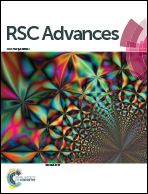Positive/negative electrocaloric effect induced by defect dipoles in PZT ferroelectric bilayer thin films†
Abstract
Double hysteresis loops induced by defect dipoles are obtained in PbZr0.52Ti0.48O3/PbZr0.8Ti0.2O3 ferroelectric bilayer thin films prepared by a sol–gel method. The migration of the defect dipoles related to the temperature and applied electric field is investigated in detail, which has a deep influence on the polarization due to the effect of the domain pinning caused by defect dipoles. Meanwhile, the electrocaloric effect based on double hysteresis loops induced by defect dipoles has been studied. The coexistence of a negative electrocaloric effect and positive electrocaloric effect has been achieved in PbZr0.52Ti0.48O3/PbZr0.8Ti0.2O3 bilayer films, ΔT = −8.4 K at 155 °C, and ΔT = 4.4 K at 45 °C. The amplifying effect of the applied electric field in the PZr0.8Ti0.2O3 layer films plays an important role in the excellent negative electrocaloric values. More interestingly, the coexistence of the negative electrocaloric and positive electrocaloric effect can be obtained by regulating the applied electric field, which is beneficial to enhancing the cooling efficiency during the cycling of the applied electric field.


 Please wait while we load your content...
Please wait while we load your content...